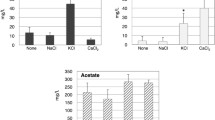Abstract
Two strains of Cyanidium caldarium which possess different biochemical and nutritional characteristics were examined with respect to their ability to utilize amino acids or 2-ketoglutarate as substrates.
One strain utilizes alanine, glutamate or aspartate as nitrogen sources, and glutamate, alanine or 2-ketoglutarate as carbon and energy sources for growth in the dark. The growth rate in the dark on 2-ketoglutarate is almost twice as high or higher than that on glutamate or alanine. During growth or incubation of this alga on amino acids, large amounts of ammonia are formed; however, ammonia formation is strongly inhibited by 2-ketoglutarate. The capacity of the alga to form ammonia from amino acids is inducible and develops fully only when the cells are grown or incubated in the presence of glutamate.
By contrast, the other strain of Cyanidium caldarium cannot utilize alanine or aspartate as nitrogen sources. It utilizes glutamate only very poorly and does not excrete ammonia into the external medium. This strain is unable to utilize amino acids or 2-ketoglutarate as carbon and energy sources for heterotrophic growth.
Cell-free extracts were tested for the occurrence of enzymes which could account for amino acid metabolism and ammonia formation.
Similar content being viewed by others
References
Allen, M. B.: The cultivation of Myxophyceae. Arch. Mikrobiol. 17, 34–53 (1952)
Allen, M. B.: Studies with Cyanidium caldarium an anomalously pigmented Chlorophyte. Arch. Mikrobiol. 32, 270–277 (1959)
Cramer, M., Myers, J.: Growth and photosynthetic characteristics of Euglena gracilis. Arch. Mikrobiol. 17, 384–402 (1952)
Danforth, W. F.: Substrate assimilation and heterotrophy. In: Physiology and biochemistry of algae, R. A. Lewin, ed., pp. 99–123. New York-London: Academic Press 1962
Doemel, W. N., Brock, T. D.: The physiological ecology of Cyanidium caldarium. J. gen. Microbiol. 67, 17–32 (1971)
Friedemann, T. E., Haugen, G. E.: Pyruvic acid. II. The determination of keto acids in blood and urine. J. biol. Chem. 147, 415–442 (1943)
Geitler, L.: Die Cyanophyceen der Deutschem Limnologischen Sunda-Expedition. Arch. Hydrobiol. Suppl. 14, 388–391 (1936)
Hirose, H.: Studies on a thermal alga, Cyanidium caldarium. Bot. Mag. 63, 107–111 (1950)
Holzer, H., Boll, M., Cennamo, C.: The biochemistry of yeast threonine deaminase. Angew. Chem., intern. Edit. 3, 101–107 (1964)
Kikuchi, T., Ishida, M. R., Matsubara, T., Tsushimoto, G., Mizuma, N.: Some features of RNA and protein syntheses in thermophilic alga Cyanidium caldarium: The effects of antibiotics on in vivo incorporation of 14C-uracil and 14C-leucine. Ann. Rep. Res. Reactor Inst. Kyoto Univ. 6, 29–37 (1973)
Klein, R. M., Cronquist, A.: A consideration of the evolutionary and taxonomic significance of some biochemical, micromorphological and physiological characters in the Thallophytes. Quart. Rev. Biol. 42, 105–295 (1967)
Kornberg, A.: Lactic dehydrogenase of muscle. In: Methods in enzymology, Vol. 1, S. P. Colowick, N. O. Kaplan, eds., pp. 441–443. New York: Academic Press 1955
Lowry, O. H., Rosebrough, N. J., Farr, A. L., Randall, R. J.: Protein measurement with the Folin phenol reagent. J. biol. Chem. 193, 265–275 (1951)
De Luca, P., Musacchio, A., Taddei, R.: Diverso comportamento in eterotrofia delle due forme di “Cyanidium caldarium” dei Campi Flegrei (Napoli). Delpinoa 12–13, 19–27 (1972)
Lynch, V. H., Gillmor, R. G.: Utilization of glutamine and glutamic acid by Chlorella pyrenoidosa. Biochim. biophys. Acta (Amst.) 115, 253–259 (1966)
McCowen, S. M., Phibbs, P. V.: Regulation of alanine dehydrogenase in Bacillus licheniformis. J. Bact. 118, 590–597 (1974)
Meers, J. L., Pedersen, L. K.: Nitrogen assimilation by Bacillus licheniformis organism growing in chemostat cultures. J. gen. Microbiol. 70, 277–286 (1972)
Ochoa, S.: Malic dehydrogenase from pig heart. In: Methods in enzymology, Vol. 1, S. P. Colowick, N. O. Kaplan, eds., pp. 735–739. New York: Academic Press 1955
Rigano, C.: Presenza dell'alga unicellulare Cyanidium caldarium (Tilden) Geitler nei terreni fumarolici dei campi Flegrei e di Ischia (Napoli). Delpinoa 6–7, 277–284 (1964)
Rigano, C.: Studies on nitrate reductase from Cyanidium caldarium. Arch. Mikrobiol. 76, 265–276 (1971)
Rigano, C., Aliotta, G., Di Martino Rigano, V.: Observations on enzymes of ammonia assimilation in two different strains of Cyanidium caldarium. Arch. Microbiol. 104, 297–299 (1975)
Rigano, C., Aliotta, G., Violante, U.: Presence of high levels of nitrate reductase activity in Cyanidium caldarium grown on glutamate as the sole nitrogen source. Plant Sci. Letters 2, 277–281 (1974)
Virtanen, A. I., Ellfolk, N.: Aspartase. In: Methods in enzymology, Vol. 2, S. P. Colowick, N. O. Kaplan, eds., pp. 386–390. New York: Academic Press 1955
Author information
Authors and Affiliations
Rights and permissions
About this article
Cite this article
Rigano, C., Fuggi, A., Rigano, V.D.M. et al. Studies on utilization of 2-ketoglutarate, glutamate and other amino acids by the unicellular alga Cyanidium caldarium . Arch. Microbiol. 107, 133–138 (1976). https://doi.org/10.1007/BF00446832
Received:
Issue Date:
DOI: https://doi.org/10.1007/BF00446832




